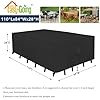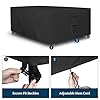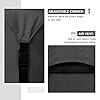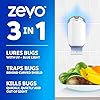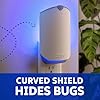Easy-Going Rectangle Patio Furniture Cover Waterproof Outdoor Dining Table and Chair Cover Anti-UV Outside Sectional Sofa Set Covers (110"L x 84"W x 28"H, Black)
$34.99 (as of November 10, 2025 16:07 GMT +00:00 - More infoProduct prices and availability are accurate as of the date/time indicated and are subject to change. Any price and availability information displayed on [relevant Amazon Site(s), as applicable] at the time of purchase will apply to the purchase of this product.)ULTCOVER 600D Tough Canvas Heavy Duty Square Patio Table and Chair Cover - Waterproof Outdoor General Purpose Furniture Covers 54 inch, Black
$46.99 (as of November 10, 2025 15:57 GMT +00:00 - More infoProduct prices and availability are accurate as of the date/time indicated and are subject to change. Any price and availability information displayed on [relevant Amazon Site(s), as applicable] at the time of purchase will apply to the purchase of this product.)Hello, Gardner’s today I have brought this article for those who are confused with the pollination process. Definitely, it’s a bit of a technical process for the indoor plants or you can take it as a challenge to resolve. But don’t worry much, in this article I promise you to make yourself sufficient to pollinate your indoor-plant. Without much effort but still with perfection.

Like, get familiar with
- What is pollination?
- How pollination occurs naturally in outdoor plants?
- Different parts of flowers
- Do all plants pollinate in the same way?
- What are the best possible ways to manually pollinate your indoor plants?
- What is the perfect time to go for manual pollination?
- How to determine whether the pollination was a success or not?
- Which factors can possibly cause unsuccessful pollination or a miscarriage?
- How to perform Indoor pollination for indoor fruits like tomato or citrus?
Let’s start with,
What is pollination?
Let me introduce you to the fertilizing parts of a flower, one is stigma hence the other is the stamen.
Stigma is the part that leads to the ovary that is the fertilizing hub of a flower. Whereas stamen contains the pollen those are yellowish powder-like materials glowing inside a flower. Mostly the stigma lies in the center of a flower and the yellow dust around it is the pollen.
Two Types Of Pollinating Flower
We further have two types of flowers regarding pollination, one that has both male and female parts inside a single flower. Those are pollinated through a Single flower pollination system.
Whereas a few plants like pumpkin and zucchini are those which have male and female flowers
and are pollinated through the Multiple flower pollination system.
The plants which have single flower pollination are easier to pollinate than those which follow the multiple flower pollination system.
Single Flower Pollination
In a single flower pollination process, the stigma and stamen, both exist in the very same premises what you need to do is to guide them towards the right path.
The Pollen lies very close to the main streamline which leads towards the ovary that is the fertilizing area of a flower. So as soon as the pollen falls into the stigma they finally reach the ovary and the process of pollination is executed.
Multiple Flower Pollination
This one is a bit technical as here the plants contain two kinds of flowers or two species of flowers. One is male and the other is female. Here the process of pollination doesn’t take place until the pollen flower is posted in the stigma of a female flower.
Naturally, this process occurs with the help of mother nature sometimes wind and sometimes bees or other animals and bugs moving around do the favor.
Why Pollination?
In the case of many indoor plants, we don’t even need pollination, as they can grow from their foliage. Pollination is not a compulsion for the health of a plant. Your indoor plant can be still lush and green even in the absence of pollination.
But it is for the Reproduction of many flowering plants as it involves the flower to create seeds and bear fruits. That can help in the plants’ reproduction i.e to reproduce several of its own kind.
Few plants can reproduce from their own parts as well, As they are vegetation experts they can regrow from their stems other tissues.
As far as the fruit-bearing and seed formation are concerned pollination is a mandatory process for the said purpose.
Best Ways To Pollinate Indoor Plants
Pollination methods can vary from plant to plant or even according to your personal choice and ease. as if you are planning manual pollination for those flowers which have both male and female parts the effort required is comparatively less.
Manual Pollination for Self-fertilizing Flowers

Those plants having self-fertilizing flowers include eggPlant, peppers, and tomatoes. They are called self-fertilizing as they don’t depend on other flowers for the Pollen or stigma, they are self-sufficient and equipped with both.
So you don’t need to put in much effort, for indoor pollination of pepper plants or eggplants or even tomatoes. You can follow any of the following pollination techniques to pollinate your indoor tomatoes or pepper plants.
Electric Toothbrush
- A kid electric toothbrush can do the wonders, what you need to do is, switch it on and put it vibrating near the flowering stem. This electric toothbrush will be acting like a bee buzzing around the flower. Creating some gentle movements and making the pollens fall to the stigma. Moreover, helping mother nature to create a few more.
Fan Operation
- You can appoint a fan in your garden that has many other benefits besides it helps in pollination. As that can act as a replacement of natural breeze may lack the other benefits of fresh air. But it’s gentle movement can contribute well to shaking the flowers as much as they drop the pollen into the stigma.
Hand Service
- Moreover, you can do a bit of hand service to the flower-bearing stems. For that, you need to give a few gentle motions without harming or plucking the stem. You can repeat this activity 4 times a week and even on a daily basis. So love your plant and your gentle motions can contribute to the health and reproduction of your indoor plant.
Manual Pollination With Multiple Flowers (Cross-Pollination)
When we are trying to pollinate indoor plants, like pumpkin or zucchini or any others those have both male and female flowers. And don’t have the capacity of self-fertilization we need to put in a bit more effort. Pollens are packed in a male flower whereas they need to reach the other female flower which has the ovary so they can bear fruit or reproduce through creating seeds.
But don’t lose hope we do have an option, as definitely the indoor plantation is in trend and you personally had witnessed a few cucumber and pumpkin bearing fruit even in an indoor kitchen garden. So how do they pollinate in the absence of natural helpers like bees and bugs or even a soothing wind?
Difference Between Male and Female flower
You first of all need to know the difference between a male and a female flower. Yes, you can easily distinguish them with their shape and sizes mostly the male flower is smaller than the female one which is bearing a small fruit beneath. Even the female flowers such as cucumber appear with a half cucumber under it. That if you get the pollinated grow into a full-size cucumber otherwise just fall off with the flower. Moreover, the male flowers appear earlier and the female one appears afterward.

Now when we are capable of distinguishing our male and female flower we can adopt any of the following techniques to get our manual pollination done so that our indoor plants too can bring fruit and produce seeds as the outdoor gardens do.
Soft Brush Technique
This technique is quite simple. You don’t need to do anything like a botanical experiment. What you need to do is
- just figure out the male flower and then
- take any soft paintbrush
- Collect a good amount of pollens on that brush (from the male flower)
- Now keep our hand stable and slowly move it towards the female flower
- Once you reach to the flower you just need to shed these pollens
- as close as possible to the central part of that female flower that is actually the stigma of that flower
- Yes that’s all now you will have to wait until nature do its job

Flower Rubbing Technique
To follow this technique of pollination of indoor plants you again need to determine the male and female flower, as you did in the prior technique. And more or less we need to follow the same procedure but the only exception is you don’t need to carry the brush.
- You will pluck out the male flower
- Bring it closer to the female flower
- While plucking, make sure that you don’t harm the anthers as they carry pollens
- Hold it right with upside up so you don’t drop a few within the way
- Once you reach your target you just need to rub the flower in such a way
- That there are maximum chances of adding the pollens to the stigma
- Now rest is again up to mother nature, which flower bears fruit and which one disappears as just a flower.

How To Determine A Successful Pollination?
Yes once you are done with the manual pollination you start waiting to check that whether it was a success or not. Being human we definitely keep a keen check on our results. So the best way to check whether your pollination was a success or a failure. keep an eye on both the plant and the flower.
But if your flower falls off without any further development that shows the process was not properly initiated and aborted somewhere. But you don’t need to worry as to whether the pollination worked or not, it still doesn’t affect your plant’s health. And until your plant is healthy you do have chances of having good fruits and effective seeds.
Causes Of Pollination Failure
Plants are living beings and behave more or less like other human beings. So if your plant is not bearing fruit at all. Or bear it and drop its un mature it is a clear symptom that your plant is under stress. Different factors that can trigger stress are
- Lack of moisture
- Lack of sunlight
- Lack or deficiency of different required nutrients
- Even an extra low or high temperature can result is fruit falling
- Another factor that causes fruit falling is that a few plants already bear too many fruits. So they abort a few to reduce the load and produce the best.
- Another problem that happens to fruit after pollination can be a puffy fruit-bearing that can be a result of higher nitrogen levels given to a plant.
- If a misshapen or a cat face is located at your plant remove it as small as possible so you can save plants energy for other healthy fruits.
Tips For A Successful Pollination
- The best time to pollinate your flowers is when the flower blooms and curl back its petals, it’s a good signal to understand that your flower is ready for pollination
- The best time to pollinate your flower is midday as that time has the lowest humidity levels, and chances of successful pollination are more.
FAQs
What’s the most effective way of pruning indoor tomato plants?
Pruning is a technical but effective thing as far as the plant growth and health is concerned. A heavy plant is not always a healthy plant. So you need to pluck out the suckers and keep the energy channeled towards the main stem and branches.
What you need to do is locate the main stem and pluck the extra little growths so that the one surviving branch can get the most effective source of energy. This method of pruning is effective for all plants as well as tomatoes.

How to pollinate indoor citrus plants?
On citrus, we mostly have male and female flowers so you need to follow the multiple flower manual pollination tips. You need to spot the female and male flowers. Then with a paintbrush, you can collect the pollen from the anther and gently rub them over the female part of the flower you can call it pistil as well. And that’s all, now wait until mother nature is blessed with a little citrus.



